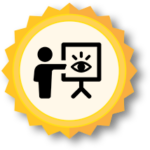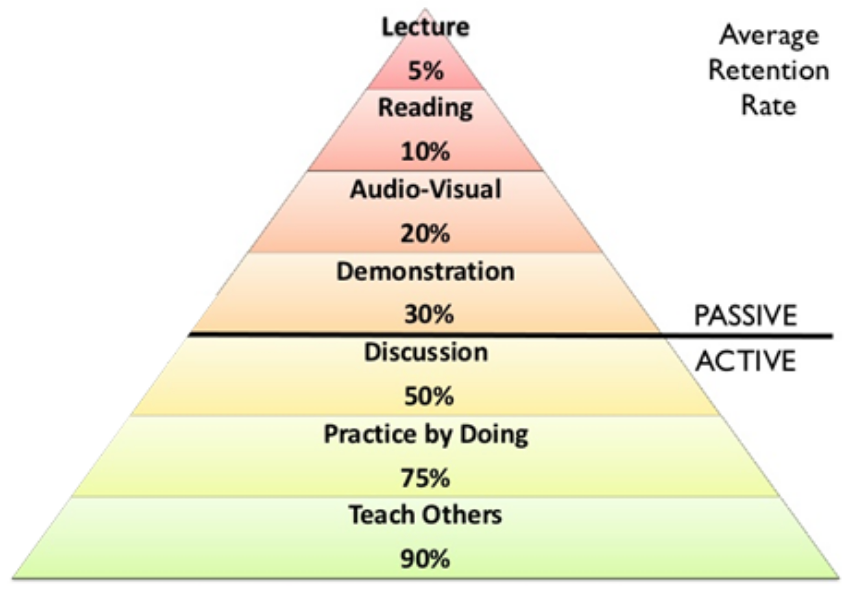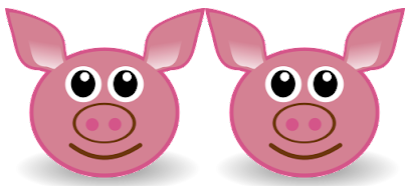Active Learning Strategy: Group Work Cooperative Learning
 Overview and Introduction: The WHAT and WHO
Overview and Introduction: The WHAT and WHO
As detailed in the Active Learning: Overview and Introduction Quick Reference Guide, active learning is a term used to describe instructional methods that increase student involvement and engagement in the learning process. As noted in the diagram below, active learning increases student retention and the most effective active learning is correlated with group work (discussing, doing, and teaching).

Figure 1: Active Learning and Retention [1]
Cooperative Learning is a structured form of group work where students pursue common goals while being assessed individually – individuals succeed when the team succeeds. The goal of Cooperative Learning is that students work together to maximize their own and each other’s learning and it may be contrasted with competitive learning (students work against each other to achieve an academic goal such as a grade of “A” that only one or a few students can attain) and Individualistic (students work by themselves to accomplish learning goals unrelated to those of the other students) learning. [2]
The figure below shows where Cooperative Learning falls in the instructor centered to student centered spectrum of the active learning process.

Figure 2: Cooperative Learning in the Active Learning Framework
Cooperative Learning is group work, but not all group work is Cooperative Learning. The key elements to Cooperative Learning are that specific tasks are being performed, there is structure to the activity, and roles are assigned. Cooperative Learning is an excellent learning tool, not necessarily an assessment activity.
Some common concerns for using Cooperative Learning in a course are:
-
- I will never cover my course content if I spend time on Cooperative Learning in class
- Students will resist, they prefer to work alone
- “Hitchhikers” – some students won’t contribute
- Students will “divide and conquer” the assignment, and they will learn only that part of the work that they completed
- “Smart” students will not want to spend time “tutoring” their slower teammates
These are legitimate concerns, however, there are a number of strategies that can help minimize these challenges. Here are some suggestions to successfully implement Cooperative Learning [3]:
-
-
- Start Small and Build – Team dynamics require time to develop, so start with small, low-risk activities to introduce students to the concept of Cooperative Learning.
- Explain Why – Explain what you’ll be doing, how it will work, and why it’s in their best interest. Expect initial resistance from students.
- Provide Incentive – Reward students for successful collaborations. The final outputs within the collaboration should come together towards a common goal.
- Make it Challenging – Choose activities that require more time and energy than one student can accomplish alone.
- Peer Review – Check in regularly with groups so you can help them develop effective group work skills and monitor possible issues. Feedback between group members and directly to you are both recommended and can be collected using tools like CATME or by creating hard-copy or digital surveys.
-

 Implementation and Timing: The WHEN, WHERE, and HOW
Implementation and Timing: The WHEN, WHERE, and HOW
Since Cooperative Learning requires more structure (unlike Collaborative Learning), most activities will be more effective during class sessions, so proper guidance can be provided. Students can work together for one class period or over several weeks to achieve a specific goal.
The 6 basic elements of Cooperative Learning (also known as PIGS FaceS) are [4]:

Figure 3: PIGS FaceS [4]
1. Positive interdependence – Group members rely on one another; all players are essential. Shared leadership and diversity are valued as assets. Each member has a specific role and responsibility and each role is connected to the other roles. Each member must participate for the entire group to succeed.
💡Consider: How will students stay committed to the group goals? How will student roles be interdependent? How will roles be assigned? How will students be motivated to act interdependently?
🛠️ Examples:
-
-
- Use Jigsaw to set up specialized experts within each team.
- Give a bonus on tests to all members with average scores over a set value.
- For a team oral report, designate which member will report on each part of the project.
-
2. Individual accountability – All students are accountable for doing their share. Clear roles are defined and all members are effective team members. Each member must demonstrate mastery of the content.
💡Consider: How will activities be relevant, interesting, and varied to motivate students? How will individual student success be recognized? How will students be kept accountable for their work? How will the experience of cooperative learning be meaningful and positive? How will the students recognize a productive group outcome?
🛠️ Examples:
-
-
- Give individual tests that cover all the material on the team assignments.
- Have students submit their sections individually.
- Make teams responsible for non-contributors not receiving credit.
- Use peer ratings to adjust individual grades on team assignments.
- Provide last resort options of firing and quitting.
-
3. Group processing – Assess the work as a team [5]. Review and reflect. Identify ways to work more effectively together in the future. View conflict as necessary and helpful and deal with it appropriately.
💡Consider: How will observations of group interactions be documented? How will guidance be provided to students to reflect on the team work? How will students set goals individually and as a group?
🛠️ Examples:
-
-
- Make teams heterogeneous in ability levels.
- Provide common blocks of time outside of class to work on assignments.
- Minimize isolation of an underrepresented team member in a group.
- Consider using CATME to organize groups.
-
4. Social collaborative skills – Develop and practice trust-building, leadership, decision making, communication, conflict management, and decision making strategies. Create a comfortable and relaxed climate where everyone can express opinions and be heard.
💡Consider: How will students social skills be assessed? How will tools be provided to develop social skills and manage conflict?
🛠️ Examples:
-
-
- Establish team policies and expectations (team norms).
- Keep groups intact for at least one month.
- Provide periodic self-assessment.
- Provide tools for managing conflict and improving team cohesiveness.
- Use crisis clinics to equip students in dealing with difficult team members.
-
5. Face-to-face interaction – Some work may be parceled out, but some must be done interactively, including giving and receiving feedback, challenging ideas, reasoning justifications, coming to conclusions, teaching, and encouraging others. Group members promote each other’s success.
💡Consider: How will students be assigned to groups? How will the space be arranged in close proximity to promote productive interaction?
6. Specific Task – The group needs to be assigned a specific task to accomplish with set criteria and communicated expectations.
💡Consider: How will the specifics of the task and set criteria be shared with the students? How will the expectations for the task be communicated?

 Rationale and Research: The WHY
Rationale and Research: The WHY
Numerous studies emphasize the need for student engagement and the classroom-based cooperative approaches that lead to increased learning are well documented [6]. Cooperative Learning benefits can be categorized into three aspects [7]:
1. Academic: In Cooperative Learning, students shift from a passive to a more active role in the learning process and the research has shown and verified that active learning is more effective than passive learning for deeper comprehension of concepts. Cooperative Learning incorporates students’ higher level thinking skills, increases student retention, and allows students to think in more complex ways. Working with peers helps in the learning process as teacher language can be translated and the mutual sharing of ideas and opinions pushes students to think more critically.
2. Affective: Cooperative Learning can benefit the emotional aspects of learning, such as enthusiasm, appreciation, and motivation. Working together cooperatively creates a social atmosphere where students receive support and feel like part of a team, leading to individual and group goal commitment. Students feel more empowered, increased self-efficacy and self-esteem, and more satisfied. Cooperative Learning increases autonomous learning, which provides greater choice and flexibility and can help students persevere when facing challenges and increases student motivation.
3. Social Competence: Cooperative Learning enables students to interact in a variety of ways and improves their ability to work with others appropriately and effectively. Learning is a social process and to complete a group task, students must navigate group interaction in order to respect one another as separate and unique individuals. Working in groups provides the opportunity to practice interpersonal social skills and cooperative skills and allows students to positively depend on each other to collectively complete the task. Cooperative Learning also provides context for students to use social language, read social cues, exchange ideas, and view things from another’s perspective. Students who feel confident in their social skills are also more likely to build a variety of mutually beneficial relationships.

 Additional Resources and References
Additional Resources and References
Acknowledgment: This work acknowledges the 2022 presentation on collaborative and cooperative learning, by Dr. Lindy Mayled as part of the Research-based Instructional Strategies in Engineering (RISE) series.
[1] The Learning Pyramid, pedagogiayandragogia, 2016, https://sites.google.com/site/pedagogiayandragogia2016/the-learning-pyramid
[2] Johnson, D. W., Johnson, R. T., & Smith, K. A., 2014, Cooperative learning: Improving university instruction by basing practice on validated theory. Journal on Excellence in University Teaching, 25(4), 1-26.
[3] Felder, R. M., & Brent, R., 2016, Teaching and Learning Stem: A Practical Guide (1st ed.). Jossey-Bass a Wiley Brand.
[4] Elsbree, Anne Rene. Cooperative Learning Resources, California State University San Marcos, 2014, https://sites.google.com/site/cooperativelearningresources/.
[5] Cornell University Center for Teaching Innovation, How to Evaluate Group Work, https://teaching.cornell.edu/teaching-resources/active-collaborative-learning/how-evaluate-group-work
[6] Millis, B. J., 2010. Cooperative Learning in Higher Education: Across the Disciplines, Across the Academy. Stylus.
[7] Loh, R.C.Y., & Ang, C. S., 2020. Unravelling Cooperative Learning in Higher Education: A review of research. Research in Social Sciences and Technology, 5(2), 22-39. doi.org/10.46303/ressat.05.02.2